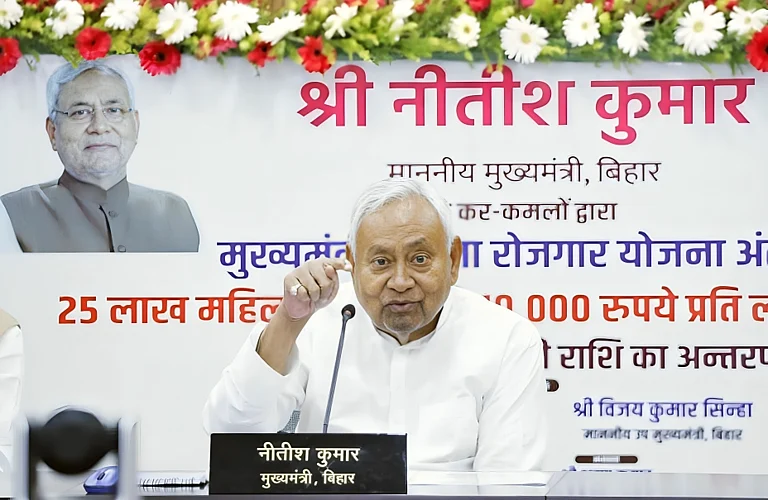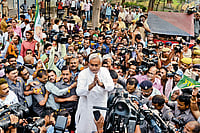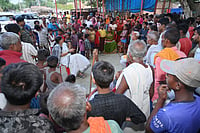Anita Devi, 36, stopped refilling the LPG cylinder five months ago and packed the gas stove in a nylon gunny bag. When I met her on a winter afternoon, she opened the bag to show the stove—a proof of her as a Ujjwala beneficiary. “LPG has become so costly that I can’t afford refills every month. So, I packed and hung the stove and cylinder,” says Anita, resident of Bajitpur Kartar panchayat in Vaishali district, around 90 km from Patna. She lives in a one-room thatched hut—with a low roof which makes even standing upright difficult—with her husband and five children. She cooks with firewood on an earthen stove; smoke from the chulha has left a thick layer of soot on the roof. Dirty clothes hang from hooks on the walls. The dank and smoky room reflects Devi’s life in abject poverty and helplessness. She has requested the mukhiya multiple times for a pucca house under the Prime Minister Awas Yojana but was denied. “He says one house was allotted to my grandfather. Hence, I am not eligible for a house, though we live separately from the extended family,” she adds.
That afternoon she had cooked rice and kabachhua, a bean that grows in the wild. Scientifically, the bean is considered healthy food but Anita does not know it. She has no money to buy green vegetables. By deciding not to refill the gas cylinder, she has freed herself from the hassle of spending Rs 1,000 every month, but Anita has to struggle for at least 10 days every month to collect firewood for cooking. “After roaming for a whole day in the forest, a kilometre away, I collect as much wood to cook for three days. So, I have to spend 10 days a month arranging woods,” she adds.
The PM Ujjwala Yojana scheme was launched in 2016 with the objective of providing clean cooking fuel like LPG to rural and underprivileged households where food is cooked with wood, coal, cowdung cakes etc. Official data show that till April this year, LPG coverage had increased to 99.8 per cent, up from 62 per cent in May 2016. The government plans to allot one crore additional LPG connections in the current financial year. It informed Parliament in March that 85,33,044 families got LPG connections under the scheme in Bihar. However, the data only provides half the story. The Comptroller and Auditor General (CAG) also said in its report that beneficiaries were not getting regular cylinder refills, leading to poor people returning to earthen chulhas for cooking.
But Bihar’s story sounds even worse in the context of Niti Aayog’s National Multi-dimensional Poverty Report that placed the state on the top with 51.9 per cent of the population living in dire poverty. Determined on the basis of school attendance, health, drinking water availability, lifestyle and other dimensions, the report was prepared from data collected by the National Family Health Survey (NFHS-IV) as the baseline. In the past, poverty was determined on the basis of per capita income. According to the report, around 51.88 per cent of the population of Bihar is deprived of nutritious food, while 45.62 per cent of pregnant women do not get health benefits. An estimated 62.20 per cent of the households still cook with wood, coal and grass, the report said.
As the embarrassed Bihar government went into damage-control mode, chief minister Nitish Kumar found support from his former deputy CM and ally BJP’s Rajya Sabha MP Sushil Kumar Modi, who questioned the very methodology used for the report. “Niti Aayog somehow prepared reports pertaining to education, health, road infrastructure and placed Bihar at the bottom. Its officials have opted for an old mechanism to evaluate things which are incorrect. They should consult the respective state governments and evaluate facilities by keeping in mind the development in the last 10 to 15 years,” Modi said.
Experts are, however, questioning the state government’s claims of progress and development over the past decade. “If the government is claiming that it has done much more, than why it is not reflecting in data?” asks economist N.K. Chaudhary. “If you do not focus on industrialisation, urbanisation, land reforms, technical education to youths and small- and medium-scale industries, the state will remain poor. This is exactly what is happening in Bihar. Merely constructing a few roads and flyovers will not ensure income of people,” Chaudhary adds.
Prabhat P. Ghosh, economist and professor at the Asian Development Research Institute (ADRI), advised the government to take the report in a positive spirit. “There is no need to be upset if the ranking is poor. But it is important to see if we have improved in the last 5-10 years or not,” Ghosh says. But Bihar’s economy has rarely been healthy. According to the Economic Survey 2020-2021 released by the state finance department, per capita income of the state is Rs 33,000. Bihar’s per capita income is 38 per cent of the national average.

The poverty ratio, using the Tendulkar Committee methodology, for Bihar was 34.1 per cent in rural and 31.2 per cent in urban areas in 2011-2012. The overall poverty stood at 33.7 per cent in the state. These ratios are much higher than all-India levels, according to the report. “The state needs extra push to increase its economic activity so that it converges towards the national average of per capita income,” the Economic Survey says.
NITI Aayog’s earlier Sustainable Development Goals India Index Report 2020-21 too paints a poor picture of the state. Bihar’s composite score on sustainable development goals is 52 out of 100, the lowest among all states. An RBI report too says that 54.4 per cent of Bihar population is living below poverty line (BPL). This means poverty alleviation programmes are not helping much and this is evident on the ground.
Life for Anita Devi and her husband Dinesh, a daily wager, is an everyday struggle. How to arrange the next meal for the family of seven—three daughters and two sons. Dinesh belongs to a scheduled caste and does not get daily work. Neither does Anita. Their work is so irregular that even after much thought, they are not able to tell how much their monthly income is. However, the last time Dinesh Das earned two hundred rupees was four days ago. “He had loaded cow dung in a vehicle-trailer for two days. He got two hundred rupees for that,” Anita recalls.
Anita also has an MNREGA job card, which says that she was enrolled for the job guarantee scheme on March 26, 2016. She worked for 20 days, but has not received the money. “I have not got any work under MNREGA after March 2016. I asked for work from the mukhiya, panchayat chief, but never got it,” she says. The irony is stark. MNREGA is the brainchild of late Raghuvansh Prasad Singh, a senior RJD leader and former rural development minister in the UPA government. The objective of this act is to provide at least 100 days of work to members of poor families in rural areas. There is a provision to give unemployment allowance to the applicant if he or she does not get work under MNREGA after 15 days of applying for work. But this is routinely flouted.
Anita gets nine kg of rice at the rate of Rs three per kg and six kg of wheat at the rate of Rs two per kg, every month from the public distribution system. Besides, nine kg of rice and six kg of wheat are given for free under the Pradhan Mantri Garib Kalyan Anna Yojana, the food security scheme of the Central government launched during the first Covid wave last year. “Ration helps to some extent, but 18 kg rice and 12 kg wheat is not enough for a family of seven,” she says.

Smoke signals Anita Devi at her home. The LPG cylinder remains but it has not been refilled for the past five months. (Photograph by Navin Kumar)
Meena Devi’s story is not too unlike Anita’s. A resident of Ravidas Tola, half a km away from Anita’s village, Meena, 53, sustains on a monthly widow pension of Rs 400. She also belongs to a scheduled caste. Her husband Ram Vinod Ram, a tannery worker in Calcutta, passed away in 2013 from asthma. She also received an LPG connection in March 2018 under the Ujjwala scheme but she has not got refills since April 2020. “My pension is just Rs 400. This is my only income. What will I do with this money? I remain ill so this money goes to medicines every month,” she says, “Every month my only daughter sends money from her in-laws’ house for food. This is how I am surviving.” She has no toilet as she has no money to build it. “For toilets, first I will have to build it with my own money and then the government will reimburse the amount. Where will I get Rs 12,000?,” she asks.
Meena is not getting the benefits of subsidised or free ration schemes either. “Whenever I visit the ration dealer, he says that my name has been removed from the beneficiary list. I went to the block and complained several times, but to no avail,” she says. Her troubles just seem to keep multiplying. Though an MNREGA job card holder, she has not got any work for the past year-and-a-half. According to the entry in Meena’s job card, she last got 20 days of work in the months of May and June in 2020. “I should have got around Rs 3,900 but I got just Rs 1,200,” says Meena.
Job card-holders are losing faith in MNREGA due to non-availability of regular work and irregular or delayed payments. There are 229 lakh MNREGA job cards in Bihar, but out of these, the number of active job cards is only 76 lakh, according to central government data. The data also shows that in the financial year 2021-2022, job card holders in Bihar got just 33.62 days of work on an average. In the last financial year, this figure was 44.65. Out of 229 lakh cardholders, only 5,555 families got 100 days of work in the financial year 2021-2022.
ALSO READ: Harry And The Bihari: Return Of The Native
Like MNREGA, promises made by the chief minister to remain unfulfilled. Last year, when a nationwide lockdown was imposed, more than 15 lakh migrant laborers returned to Bihar. Biharis accounted for about 14.3 per cent of the migrants who returned to their hometowns, according to government data. Nitish Kumar had talked to dozens of migrant workers and had promised jobs in the state to almost all the workers he talked to through video conferencing. But most of them didn’t get any work and had to migrate to other states as soon as the travel restrictions were lifted.
42-year-old Kailash Ravidas, a disabled man from Nawakadih village in Jamui, still remembers his interaction with the CM on May 24 last year. He had just returned from Calcutta, where he had been working as a shoemaker for more than twenty years. He managed to take a bus which charged Rs 1,800, nearly seven times the normal fare, to Bihar. “I thanked the chief minister for starting my disability pension. I asked him to give me employment here, because I do not want to go back to Calcutta. On this Nitish Kumar said: ‘Don’t worry, you will be taken care of’.” It has been one-and-a-half years but the promised employment is nowhere in sight. Finally, he went back to Calcutta in January this year. But Kailash could stay there only for three months when the second wave of Covid started in April and a lockdown was imposed. “I stayed for 15 days in Calcutta without any work. Meanwhile, a train was running, so I took it and returned to the village,” Kailash narrates. He stayed in the village for three months, but did not get any work this time either. Subsequently, he returned to Calcutta in July. Last month, he was diagnosed with a “serious illness”, which doctors have not revealed to him. “In these one-and-a-half years, the government did not bother to ask how I was surviving. If the government had given me some money, I would have done some business here. I make footwear. Had there been a factory here, I would have done the same work in the factory here,” he says. Due to deteriorating health, now might not be able to work as much as before, but Kailash still wants to return to Calcutta. “Earlier, I used to do work worth Rs 400-500 a day. Now, I will not be able to do that much, but it is very easy to get government treatment in Calcutta. So I will return for the sake of my health,” he adds.
Last year, when lakhs of migrant workers returned to Bihar during the lockdown, the government had done their skill mapping so that they could be employed. The mapping revealed that around 8.40 lakh workers were associated with construction work, which means a large proportion of Bihar workers are unskilled. Outlook spoke to dozens of workers who said that lack of work and satisfactory wages forced them to migrate again. Those who stayed here are either unemployed or get irregular work with less than normal wages.

Only on paper Meena Devi has an MNREGA job card but no work in a long time. (Photograph by Navin Kumar)
The irony is that, let alone the work, construction workers are not even getting the benefits of schemes run for their welfare under the Building and Other Construction Workers Welfare Board, which runs a dozen schemes like education of children of construction workers, loans for housing, and health services, among others. But according to the CAG report, at present, the government is spending money for only seven of these schemes.
There are nearly 14 lakh workers registered with the welfare board, but only 2.5 lakh have enjoyed benefit of the schemes, according to the CAG report. The report further states that Rs 1,702 crore is available with the welfare board, but only 4.89 per cent of the amount—Rs 83 crore—was spent for welfare of construction workers. Mannu Kewat, 42, of Takiyakala village in Nalanda, Nitish Kumar’s home district, would testify to the problems of construction workers, especially in the post-pandemic world. He reaches Labour Chowk, a km away from his home every morning, and waits for prospective employers. “Work is available only for 10 to 15 days in a month. Sometimes I have to take out a loan. Five years ago, I had registered with the welfare board with the hope that it would help in getting children good education and subsidised healthcare facilities. But I have not got a single rupee from the board in the last five years.”
Awanish Kumar, British Academy Newton International Fellow at the University of Edinburgh and a researcher on agrarian issues in Bihar, links poverty with socio-economic and political context. “Poverty generally is produced in a socio-economic and political context. Another way to say this is to say that poverty cannot be eradicated unless we abolish the conditions that create it. What are such conditions in Bihar? Poverty cannot be understood without reference to land, urbanisation, sanitation, etc. In fact, this is the multidimensionality of poverty,” he says. “In all sincerity, I don’t know if it is still fashionable to ask these questions: what happened to the long-promised land reforms? Or the common school system? Finally, poverty cannot disappear without solidarity among the people, meaning that citizens feel for each other and come together for shared interests. We need deep social reforms that destroy the structures of caste, gender and other forms of segregation and oppression,” Kumar adds.
Amid the scary data, there is a silver lining for Bihar. And proof that if properly implemented, government schemes can bring about a change. And that is what Jeevika, which translates to employment, has achieved. It has empowered women at village level on a huge scale.
Ajmeri Khatoon, 25, of Bherihari Harijan Tola in West Champaran district, was dependent on her husband’s earnings to run the house until three years ago. But now she runs a grocery shop and is financially independent. Income from the grocery shop and earning from her husbands had made the family financially sound to some extent.
And all these happened in 2013 when she joined Jeevika, a poverty alleviation initiative of the rural development department launched in 2006 with World Bank aid.
“Three years ago, I opened a grocery shop after taking a loan of Rs 30,000 from Jeevika at the rate of only one per cent. The grocery store has been doing well since then and it is helping a lot in running the family,” Ajmeri says. Ajmeri was married at the age of just 15 and is now the mother of four—two daughters and two sons. She has got both the daughters admitted to a private school. Her younger sons are studying at an anganwadi centre.
“Jeevika has helped thousands of women like me. The biggest benefit we get a loan at very low interest. Mahajans (money lenders) give loan at 10 per cent interest. I was myself drowning in the debt of mahajan. Now I am paying off the debt by taking a loan from Jeevika,” she adds. So far, Jeevika has been able to reach out to nearly 1.17 crore rural poor households by organising them into 10 lakh women self-help groups.
If Bihar is a study in contrast, one need not look beyond Ajmeri and Anita’s lives. And therein lies the state’s problems. As long as the divide remains, one half of the state will continue to wallow in poverty. And continue to put Bihar on top of the poorest states list.
(This appeared in the print edition as "State of Emptiness")
Umesh Kumar Ray is a freelance journalist



























